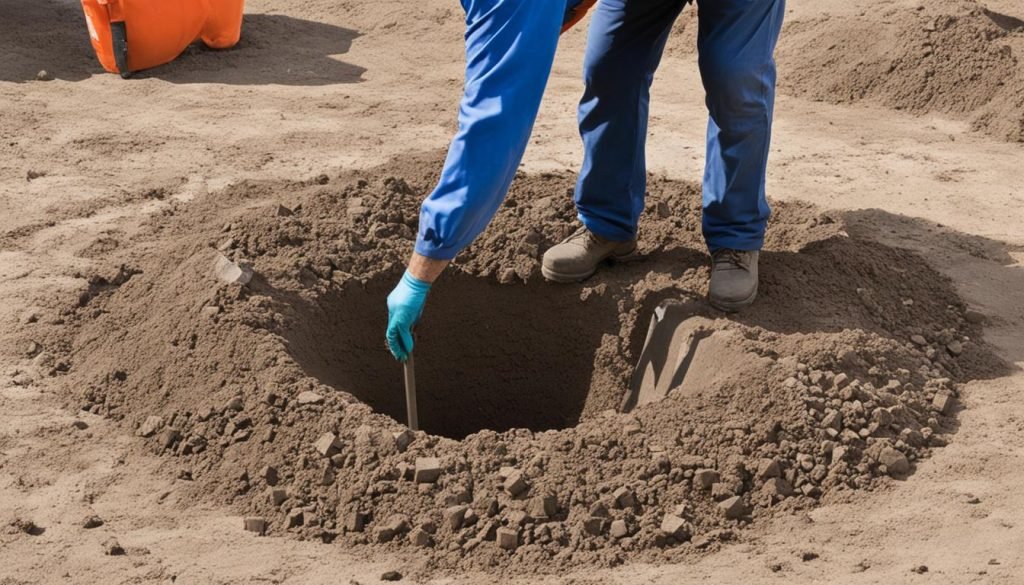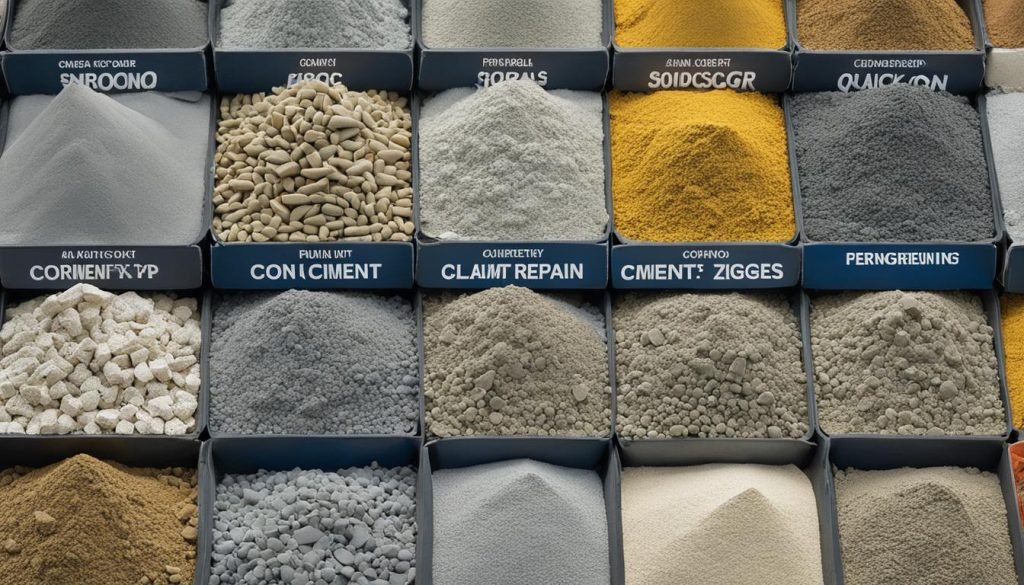Determining the number of cubes in a bag of concrete is crucial for any construction project. By understanding the quantity of cubes in a concrete bag, you can accurately calculate the amount of concrete you need to complete your project. In this article, we will explore the step-by-step process to calculate the number of cubes in a bag of concrete. Click here to Find a reliable concreter in Toowoomba for innovative concrete solutions. Expand your construction skills by considering this comprehensive guide on How to Build a Deck on Concrete Slab: Step-by-Step Guide. Gain valuable insights and step-by-step guidance for success in building a deck on a concrete slab.
Key Takeaways:
- Calculating the number of cubes in a concrete bag is essential for accurate material estimation in construction projects.
- Understanding the formulas and step-by-step process for cube calculation can help you determine the number of bags required for your project.
- Consider using a concrete calculator for non-rectangular shapes to ensure accurate cube estimation.
- Proper curing and choosing the right cement type are crucial factors for the strength and durability of your concrete projects.
- Easy Mix premixed bags offer high-quality solutions for various concrete applications, ensuring excellent results.
Calculating Cubes for a Concrete Slab
To ensure accurate material estimation for your concrete slab, it is crucial to calculate the number of cubes required. This calculation depends on the dimensions of the slab and involves a step-by-step process.
First, measure the length, width, and depth of the area in meters. These measurements will serve as the basis for determining the cubic meters of concrete needed.
Once you have the dimensions, use the formula: length × width × depth to calculate the total cubic meters. For example, if the length is 2 meters, the width is 3 meters, and the depth is 0.375 meters, the calculation would be:
2 × 3 × 0.375 = 2.25 cubic meters
After obtaining the total cubic meters, multiply it by 100 to determine the number of bags of concrete required. Continuing with the previous example:
2.25 cubic meters × 100 = 225 bags
Since concrete bags are typically sold in whole numbers, round up the result to the nearest whole number. In this case, you would need approximately 225 bags to complete the project.
Calculating Cubes for Installing Posts
When it comes to installing posts, accurately determining the number of cubes needed is essential for a successful construction project. In addition to measuring the height and width of the post, it’s important to calculate the depth of the hole required. By using the appropriate formulas, you can determine the cubic meters of both the post section and the hole, and calculate the total cubic meters needed.
Let’s break down the process step by step:
- Measure the height and width of the post.
- Calculate the depth of the hole required based on the type of post and the specific project requirements.
- Use the respective formulas to determine the cubic meters of the post section and the hole. For example, the formula for calculating the cubic meters of a cylindrical hole is π * (radius^2) * depth.
- Subtract the cubic meters of the post section from the cubic meters of the hole to get the total cubic meters.
- Multiply the total cubic meters by 100 to determine the number of bags needed. This accounts for the fact that there are typically 100 cubes in a bag of concrete.
For example, let’s say the total cubic meters required for your project is 0.012. To ensure sufficient coverage, it would be best to use approximately 1.5 bags of concrete.
By following these calculations, you can confidently estimate the number of concrete bags needed for installing posts. This will ensure that you have the right amount of material for a sturdy and reliable construction.
Using a Concrete Calculator for Non-Rectangular Shapes
When it comes to calculating the amount of concrete needed for non-rectangular shapes, precision is key. Using a concrete calculator can help you accurately determine the quantity of concrete required for irregular or unique shapes. These calculators take into account the specific dimensions and shape of the area, allowing you to get an estimate of the number of cubes needed.
Whether you’re working on curved walkways, circular patios, or irregularly shaped structures, a concrete calculator can simplify the process of material estimation. By inputting the measurements of the different sections and accounting for the depth, the calculator can provide you with the number of concrete cubes required.
By using a concrete calculator, you can avoid overordering or underordering concrete, saving both time and money on your construction project. These calculators are especially useful when dealing with complex shapes that cannot be easily approximated using traditional methods.
Using a concrete calculator for non-rectangular shapes ensures accuracy and avoids unnecessary wastage or shortages of concrete. It allows you to plan your project effectively and helps you make informed decisions regarding your material requirements.
Advantages of Using a Concrete Calculator:
- Accurate estimations for non-rectangular shapes
- Saves time and money by avoiding material wastage
- Helps in planning and budgeting for the project
- Reduces the risk of ordering incorrect quantities of concrete
- Eases the calculation process for complex shapes
With the advancement of technology, many concrete companies and construction websites offer online concrete calculators. These calculators are user-friendly and accessible, ensuring that even those without extensive construction knowledge can make accurate material estimations.
Next, let’s explore some popular concrete calculators that can be used for determining the number of concrete cubes required for your non-rectangular project.
Recommended Concrete Calculators:
| Concrete Calculator | Description |
|---|---|
| Builder’s Concrete Calculator | An easy-to-use calculator that provides accurate estimates based on the shape and dimensions of your project area. |
| Concrete Volume Calculator | This calculator helps you determine the quantity of concrete required by taking into account the depth, length, and width of the area. |
| Concrete Estimator | A comprehensive calculator that allows you to input the specific shape and dimensions of your project, providing an accurate estimation of concrete needed. |
Using these calculators, you can ensure that you have the right amount of concrete to complete your non-rectangular project successfully. Remember, accurate material estimation is crucial for the smooth execution of any construction endeavor.
Recommended Products for Concrete Projects
When undertaking concrete projects, using the right products is essential for achieving quality results. Easy Mix offers a range of premixed bags that are suitable for various applications, including Quick Set Concrete, Super Strength Concrete, Rapid Set Concrete, Concrete Mix, and Post Mix Concrete. These products provide high cement content, increased strength, durability, and workability, making them ideal for different concrete projects.
Whether you’re working on a small DIY project or a large-scale construction endeavor, Easy Mix premixed bags are designed to simplify your concrete mixing process. These convenient bags come with pre-measured ingredients, ensuring accurate proportions and consistent results. With Easy Mix, you can save time and effort by eliminating the need to measure and mix individual components.
Here are some of the recommended Easy Mix products for specific concrete applications:
- Easy Mix 32MPa Quick Set Concrete: Perfect for projects that require fast-setting concrete, such as setting posts, repairing paths, or creating small slabs. This high-quality blend provides excellent workability and allows you to complete your project in no time.
- Easy Mix 55MPa Super Strength Concrete: If you’re working on demanding projects that require exceptional strength and durability, this is the ideal choice. It offers enhanced load-bearing capacity, making it suitable for heavy-duty construction projects and structural applications.
- Easy Mix Rapid Set Concrete: When time is of the essence, this rapid-setting concrete mix is the solution. It sets quickly, allowing you to move on to the next phase of your project without unnecessary delays. Perfect for situations where immediate functionality is required.
- Easy Mix Concrete Mix: A versatile all-purpose mix that is suitable for a wide range of concrete applications. It provides excellent workability and can be used for general construction, small slabs, footpaths, and more. This mix offers a perfect balance between strength and workability.
- Easy Mix Post Mix Concrete: Specifically formulated for installing fence posts, mailbox posts, and other similar applications. This mix is designed to provide secure and stable foundations for your posts, ensuring long-lasting performance.
Using Easy Mix premixed bags not only simplifies the concrete mixing process but also ensures consistent results. These high-quality products are trusted by professionals and DIY enthusiasts alike for their reliability and performance.
With Easy Mix, you can confidently tackle your concrete projects, knowing that you have the right products for the job. Whether you’re laying a concrete slab, installing posts, or undertaking any other concrete construction, choose Easy Mix for the best results.
Tips for Laying a Concrete Slab
When it comes to laying a concrete slab, following the right steps is crucial for a successful outcome. By taking the necessary precautions and using the correct materials, you can ensure the longevity and strength of your slab. Here are some tips to guide you:
- Prepare the area: Before pouring the concrete, make sure the area is properly excavated and leveled. Remove any debris, rocks, or vegetation that may interfere with the slab’s stability.
- Use the correct mix: Choosing the right concrete mix is essential. Easy Mix offers a range of premixed bags that are specifically formulated for different applications. Select the mix that suits your project, whether it’s a standard concrete mix or a specialty mix for enhanced strength or rapid setting.
- Calculate the quantity: To determine the number of concrete bags needed for your slab, you can use an online calculator or refer to the bag’s instructions for coverage area. Remember to account for wastage and have some extra bags on hand.
- Placing the concrete: Start pouring the concrete into the slab area, ensuring a consistent and even flow. Use a screed board and a bull float to level the surface, removing any excess concrete.
- Finishing the surface: Once the concrete has been placed, you can apply the desired finish to the surface. This can be done using a trowel, broom, or decorative stamping tools, depending on the look you want to achieve.
- Consider weather conditions: Pay attention to the weather forecast before laying the slab. Extreme temperatures, rain, or strong winds can affect the curing process and the overall quality of the concrete. Take appropriate measures to protect the slab from adverse conditions.
- Allow for proper curing time: Curing is crucial for the concrete to develop its full strength. Follow the recommended curing time provided by the manufacturer and ensure the slab is kept moist during this period.
Proper preparation, the right mix, and careful execution are the keys to a successful concrete slab. Taking the time to plan and follow these tips will help you achieve a durable and long-lasting result.
For a visual representation of the steps involved in laying a concrete slab, refer to the image below:
| Steps for Laying a Concrete Slab | Description |
|---|---|
| 1. Prepare the area | Excavate and level the area, removing any debris or vegetation. |
| 2. Use the correct mix | Select the appropriate Easy Mix concrete bag for your project. |
| 3. Calculate the quantity | Estimate the number of concrete bags needed for the slab. |
| 4. Placing the concrete | Pour the concrete evenly into the slab area and level the surface. |
| 5. Finishing the surface | Apply the desired finish to the concrete surface. |
| 6. Consider weather conditions | Take weather conditions into account before pouring the slab. |
| 7. Allow for proper curing time | Follow the recommended curing time for the concrete to set. |
By following these tips and using Easy Mix concrete bags, you can lay a concrete slab with confidence, knowing that it will provide a sturdy foundation for your construction project.
Tips for Installing Posts with Concrete

Installing posts with concrete requires careful planning and execution to ensure the stability and durability of the structure. Follow these helpful tips to achieve secure and long-lasting post installations.
1. Accurate Measurements
Start by accurately measuring the height and width of the posts. This will help you determine the dimensions of the hole needed for installation. Precise measurements are essential for ensuring a proper fit and stability.
2. Calculate Depth of the Hole
Calculate the depth of the hole based on the height of the posts. As a general rule of thumb, the depth should be one-third the height of the posts. This provides a strong foundation and prevents the posts from shifting over time.
3. Use the Right Concrete Mix
Selecting the appropriate concrete mix is crucial for post installations. Easy Mix offers a reliable post mix concrete that is specifically formulated for this purpose. It provides excellent strength and bonding properties, ensuring the posts remain secure in the ground.
4. Proper Compaction
After pouring the concrete mix into the hole, use a rod or stick to compact the mixture. This will eliminate any air pockets and enhance the overall stability of the installation. Ensure the mix is thoroughly compacted to achieve maximum strength.
5. Curing and Protection
Once the concrete is poured and compacted, it is important to allow it to cure properly. Keep the area moist for at least seven days to ensure the concrete reaches its full strength. Additionally, protect the posts and curing concrete from extreme weather conditions to avoid cracking or damage.
| Product | Strength | Setting Time | Usage |
|---|---|---|---|
| Easy Mix 32MPa Quick Set Concrete | 32MPa | Quick Setting | Perfect for fast installation of fence posts and letterboxes. |
| Easy Mix 55MPa Super Strength Concrete | 55MPa | Fast Setting | Ideal for heavy-duty applications such as retaining walls and structural posts. |
| Easy Mix Rapid Set Concrete | 25MPa | Rapid Setting | Suitable for general-purpose use, offering a quick setting time for efficiency. |
Importance of Proper Curing for Concrete Projects
Proper curing plays a critical role in ensuring the strength and durability of concrete projects. Curing refers to the process of keeping the concrete surface moist and protected from excessive moisture loss during the early stages of hydration. This allows the concrete to develop its full strength over time and enhances its long-term performance.
Concrete projects, whether it’s a slab, a post, or any other structure, require proper curing to achieve optimal results. Curing provides numerous benefits, including:
- Promoting hydration: Curing helps to maintain the necessary moisture content in the concrete, facilitating the ongoing hydration reactions between cement and water. This allows the concrete to gain strength and hardness.
- Preventing cracking: By keeping the concrete moist, proper curing minimizes the risk of plastic shrinkage cracks and surface cracking. It allows the concrete to dry gradually and evenly, reducing the formation of stress-induced cracks.
- Improving durability: Adequate curing enhances the durability of concrete by reducing permeability, increasing resistance to abrasion, and improving resistance to chemical attack. It ensures that the concrete can withstand the effects of exposure to harsh environments.
- Enhancing aesthetics: Properly cured concrete tends to have a more uniform color and texture, contributing to the overall visual appeal of the finished project.
The duration of curing depends on various factors, including the type of cement used, ambient conditions, and the size and complexity of the concrete project. As a general guideline, curing should continue for at least seven days. However, certain conditions may require longer curing periods to ensure optimal strength development.
During the curing process, it is crucial to keep the concrete surface consistently moist through methods such as ponding, wet coverings, or curing compounds. This prevents the evaporation of moisture and allows the hydration reactions to proceed effectively.
Remember, proper curing is a fundamental step in concrete construction that should not be overlooked. It significantly influences the strength, durability, and overall performance of the finished project. By following recommended curing practices and allowing sufficient curing time, you can ensure the longevity and quality of your concrete projects.
Curing Techniques:
There are several effective techniques for proper curing of concrete, including:
- Wet Coverings: Covering the concrete with wet blankets, burlap, or similar materials to keep it continuously moist.
- Ponding: Creating a pond of water over the concrete surface to maintain a moist environment.
- Curing Compounds: Applying liquid curing compounds that form a film on the concrete surface, preventing moisture loss.
- Plastic Sheets: Covering the concrete with plastic sheets or membranes to retain moisture.
These techniques can be used individually or in combination, depending on the specific requirements of the project.
Proper curing ensures that your concrete projects achieve the required strength, durability, and aesthetics. Don’t overlook this crucial step in your construction process. Take the time to follow appropriate curing techniques and allow sufficient curing time for the best possible results.
Understanding Cement Types for Different Applications

When it comes to concrete applications, choosing the right type of cement is crucial for achieving optimal results. Different cement types have varying characteristics and properties that make them suitable for specific projects. By understanding the distinctions between these cement types, you can make informed decisions and ensure the success of your construction endeavors.
“The right cement type can make a significant difference in the performance and durability of your concrete.”
Here are some commonly used cement types and their applications:
- General-Purpose Cement: This type of cement is versatile and commonly used for a wide range of applications, including general construction, such as residential buildings, pathways, and driveways. It provides satisfactory strength and durability for most projects.
- Builders Cement: Builders cement is specifically formulated for structural applications. It offers enhanced strength and durability, making it ideal for constructing foundations, bridges, and other load-bearing structures.
- Off-White Cement: Off-white cement is aesthetically pleasing and is often used in projects that require a decorative finish, such as colored concrete surfaces, architectural elements, and artistic sculptures.
- High Early Strength Cement: As the name suggests, high early strength cement is designed to develop strength rapidly. It is commonly used in time-sensitive projects where quick setting and early load-bearing capacity are crucial.
- Special-Purpose Cement: Special-purpose cement includes various types tailored for specific applications, such as sulfate-resistant cement for areas prone to chemical attack, low-heat cement for reducing the risk of thermal cracking, and masonry cement for mortar and stucco applications.
Before choosing a cement type, consider the requirements and demands of your project. Evaluate factors such as strength requirements, durability, aesthetics, and environmental conditions to determine the most suitable cement for your needs.
The Importance of Choosing the Right Cement Type
By selecting the appropriate cement type, you can ensure that your concrete structures possess the necessary strength, durability, and aesthetic appeal. Furthermore, using the right cement helps minimize the risk of issues such as cracking, deterioration, and reduced performance over time.
Keep in mind that cement is only one component of the concrete mix. Additional factors, such as aggregate selection, water-cement ratio, and proper curing techniques, also influence the overall performance of your concrete.
Next, we’ll delve into a handy ready reckoner that can assist you in estimating the quantity of concrete and mortar mix required for various projects.
Handy Ready Reckoner for Concrete and Mortar
The Ready Reckoner is a valuable tool for estimating the quantity of concrete and mortar mix required for a wide range of projects. Whether you’re planning a small DIY task or a large-scale construction project, the Ready Reckoner can simplify the process of determining the number of bags you’ll need.
Using calculations based on the area, volume, or number of bricks or posts, the Ready Reckoner provides accurate estimates, saving you time and effort. With this handy guide, you can avoid overestimating or underestimating your material requirements, ensuring efficient and cost-effective planning.
Here’s an example of how the Ready Reckoner works:
- Measure the dimensions of your project. For instance, if you’re planning to build a concrete slab, measure the length, width, and depth.
- Consult the Ready Reckoner and locate the relevant section for your project type.
- Enter the measurements into the provided fields, and the Ready Reckoner will calculate the approximate number of bags required.
The Ready Reckoner not only applies to concrete mix but also mortar mix. Whether you’re laying bricks, building walls, or carrying out other masonry work, this tool can provide accurate estimations for your mortar requirements.
Take a look at the table below for a quick reference on the coverage of popular concrete and mortar mix products:
| Product | Coverage (approx.) |
|---|---|
| Ready Mix Concrete | 1 bag covers an area of 0.15 cubic meters |
| Mortar Mix | 1 bag covers an area of 0.02 cubic meters |
By referring to the Ready Reckoner and utilizing its accurate calculations, you can ensure the efficient use of concrete and mortar mix, reducing waste and saving money. This handy tool is a valuable resource for both professionals and DIY enthusiasts alike.
Conclusion
Calculating the number of cubes in a concrete bag is crucial for accurate material estimation in construction projects. By following the recommended formulas and utilizing tools such as concrete calculators and Ready Reckoners, you can determine the exact number of bags required, ensuring the success of your concrete projects.
It is essential to choose high-quality products like Easy Mix premixed bags to achieve optimal results. Easy Mix offers a range of premixed bags, including the Easy Mix 32MPa Quick Set Concrete, Easy Mix 55MPa Super Strength Concrete, Easy Mix Rapid Set Concrete, Easy Mix Concrete, and Easy Mix Post Mix Concrete.
In addition to accurate calculations and selecting the right products, it is equally important to follow proper curing techniques. Adequate curing enhances the strength and durability of the concrete, ensuring long-term performance. Remember to allow sufficient curing time for your project, following the recommended guidelines.
By implementing these steps, you can confidently estimate the number of bags required, select the appropriate products, and ensure proper curing for your concrete projects, resulting in successful outcomes and lasting constructions.
FAQ
How do I calculate the number of cubes needed for a concrete slab?
Measure the length, width, and depth of the area, convert the measurements to meters, and use the formula: length x width x depth. Then, multiply the total cubic meters by 100 to determine the number of bags needed.
How do I calculate the number of cubes needed for installing posts?
Measure the height and width of the post, calculate the depth of the hole required, and determine the cubic meters of the post section and the hole. Subtract the cubic meters of the post section from the cubic meters of the hole to get the total cubic meters. Multiply the total cubic meters by 100 to determine the number of bags needed.
What should I do if the shape is not rectangular or square?
It is recommended to use a concrete calculator to determine the amount of concrete needed. These calculators take into account the specific dimensions and shape of the area to provide an accurate estimate of the number of cubes required.
What are the recommended products for concrete projects?
Easy Mix offers a range of premixed bags suitable for various applications, including Quick Set Concrete, Super Strength Concrete, Rapid Set Concrete, Concrete Mix, and Post Mix Concrete. These products provide high cement content, increased strength, durability, and workability.
What are some tips for laying a concrete slab?
Prepare the area, use the correct mix of Easy Mix concrete bags, place the concrete, and finish the surface. Also, consider factors such as weather conditions and curing time for the longevity and strength of the slab.
What are some tips for installing posts with concrete?
Measure the height and width of the posts accurately, calculate the depth of the hole, use the appropriate mix of Easy Mix post mix concrete, and ensure proper compaction and curing for sturdy and secure post installations.
Why is proper curing important for concrete projects?
Proper curing is crucial for the strength and durability of concrete projects. It involves keeping the surface moist and protected from excessive moisture loss. Curing should be done for a minimum of seven days, and longer under certain conditions.
What are the different types of cement available?
The different types of cement include general-purpose cement, builders cement, off-white cement, high early strength cement, and special-purpose cement. Understanding the characteristics and properties of each type will help you choose the right one for your project.
What is the Ready Reckoner and how can it help me?
The Ready Reckoner is a useful tool for estimating the quantity of concrete and mortar mix required for various projects. It provides calculations based on the area, volume, and number of bricks or posts, making it easier to determine the number of bags needed.
Why is it important to calculate the number of cubes in a concrete bag?
Calculating the number of cubes in a concrete bag is essential for accurate material estimation in construction projects. By following the recommended formulas and using tools such as concrete calculators and Ready Reckoners, you can calculate the required number of bags and ensure the success of your concrete projects.




